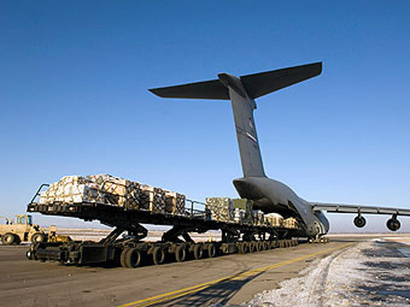Kyrgyzstan, Russia discuss logistics center planned at Bishkek airport

By Aynur Jafarova
Kyrgyzstan and Russia have discussed establishment of a logistics center at the Manas international airport in Bishkek, the Kyrgyz transport and communications ministry said, local news agency KirTAG reported Thursday.
According to the report, during the first stage of consultations, a delegation of Russia's Transport Ministry including representatives of the body in charge of state policy in civil aviation, the Federal Air Transport Agency (Rosaviatsia), state-controlled airline Aeroflot and two other airlines visited Manas and got acquainted with the infrastructure of the facility.
The Kyrgyz transport ministry said that Central Asia is becoming an increasingly important region for international civil aviation, used both for passenger and cargo transportation.
"Manas has to become a major center of international logistics and increase cargo flights between the developed markets of Western Europe and South-East Asia through Kyrgyzstan, which will shorten the distance during creation of the so-called 'southern route', " the ministry said.
"Kyrgyzstan can be considered as the best place in terms of geographical location for the creation of a modern air freight transit complex," it said.
The cargo complex at the Manas airport is currently designed to process 200 tons of cargo a year.
Kyrgyz President Almazbek Atambayev in late December confirmed that following withdrawal of the U.S. military men the airport has to become an entirely civilian facility.
Atambayev has repeatedly said his country will not extend the stay of foreign military in its civil airport under any circumstances.
But US expert on Central Asia Bruce Pannier believes that foreign bases in the Central Asian countries are likely to stay in spite of the statements by the countries' leaders and the key will be the terms they use for these facilities.
"No one will call them 'bases'," Pannier said in October. "The same thing happened at Manas when it changed from being a base to a 'transit center'."
US Assistant Secretary of State for South and Central Asia Robert Blake said that the agreement between the U.S. and Kyrgyzstan on the use of the transit center at the Bishkek airport expires in mid-2014 and there is still time to prepare a new agreement, Russian news agency ITAR-TASS reported in July.
Blake explained that much will depend on the situation prevailing after the withdrawal of U.S. troops from Afghanistan by the end of 2014 and on the need of further assistance to this country. The U.S. may have to keep a limited military contingent there in accordance with an agreement on security issues which is planned to be signed with Kabul in the fall of 2013.
"By that time we will have a clearer idea of what facilities we may need in Central Asia," the US diplomat said. "So we'll have to wait for an agreement on security issues in Afghanistan to determine exactly how much we need Manas."
The U.S. embassy in Kyrgyzstan said in October that Bishkek and Washington were not holding official negotiations on the future of the Manas transit center, according to AKIpress news agency.
The Transit Center, formerly called a military base, was opened at the Manas airport in late 2001. The center is a major logistics hub for transportation of goods and the anti-terror coalition forces to Afghanistan. At present, it accommodates about 1,200 US soldiers. According to Pentagon statistics, the base handles up to 15,000 coalition servicemen and 500 tons of cargo a month, Azerbaijani news agency Trend reported.
Kyrgyz statistics show that the airport serves 1.1 million passengers a year. If it suspends its main activity, the figure will drop to 300,000-400,000 people, and the airport will sustain a loss of $7.65 million annually.
It is estimated that if the new airport were to work at full capacity, freight can bring a profit of $250 million per year, and maintenance of commercial aircraft would bring another $150 million.
Here we are to serve you with news right now. It does not cost much, but worth your attention.
Choose to support open, independent, quality journalism and subscribe on a monthly basis.
By subscribing to our online newspaper, you can have full digital access to all news, analysis, and much more.
You can also follow AzerNEWS on Twitter @AzerNewsAz or Facebook @AzerNewsNewspaper
Thank you!
